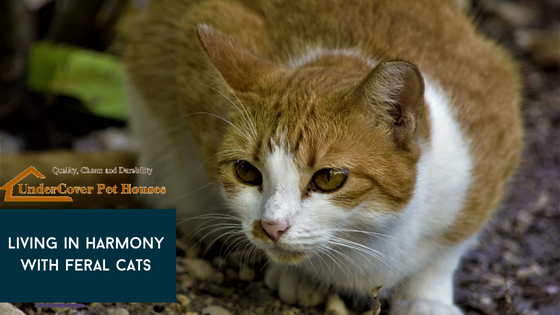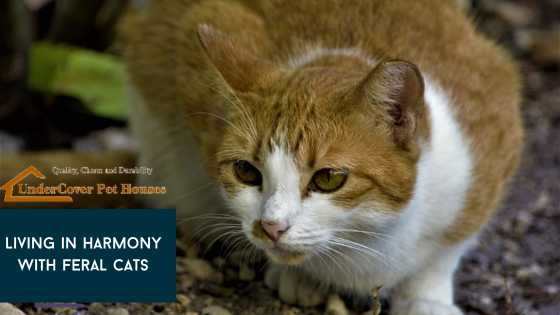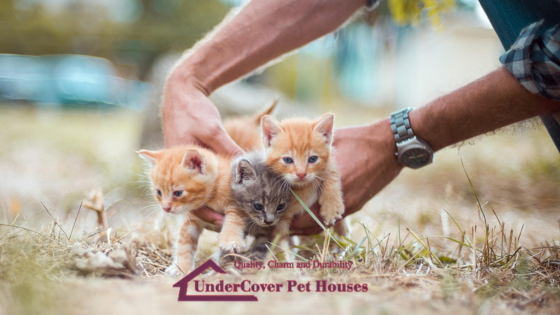 Loading... Please wait...
Loading... Please wait...Blog - OUTDOOR CAT
The Ultimate Guide to Pet Houses (Everything You Need to Know)
Posted by Danny MacDonald on 2024 Apr 2nd

Owning a pet brings joy, but it also comes with responsibilities. One of the responsibilities involves providing a safe and comfortable space for our beloved feline companions, especially if you own an indoor cat or care for feral cats.
Just like humans, pets need a safe space to call their own—a haven where they can rest, relax, and play. In this guide, we'll explore everything you need to know about pet houses for cats, from choosing the right type to creating a cozy retreat space that your feline will love.
Choosing the Right Pet House
Cat houses come in various sizes, shapes, and designs to accommodate different types of cats and their unique needs. Whether you have an indoor or outdoor cat, there's a pet house out there to suit your furry friend—the options are endless.
Consider your cat's size, breed, and personality when picking a cat house.
For instance, larger cat breeds may require spacious houses with ample room to move around, while smaller cats could be okay with smaller but cozy spaces. When it comes to outdoor cats, many specialized outdoor cat house options exist to cover the different needs of your outdoor cat.
Remember, it's essential to choose a cat house that provides enough space and comfort for your pet to feel secure, safe, and relaxed. You can also personalize the pet house by adding add-ons such as soft beds and cat blankets to curl up on.
Materials
The materials used to construct your cat house are primarily in its safety, comfort, and durability. Wooden cat houses are made from cedar or pine due to their natural insulation properties and weather resistance.
Conversely, plastic and fabric cat houses are lightweight and easy to clean, making them ideal for indoor cat use. Whichever material you decide on, ensure it's safe, non-toxic, and durable enough.
The Location
The location of your pet's house can affect its comfort and well-being. Outdoor pet houses are best placed in a shaded spot away from harsh weather conditions. Also, elevating your outdoor cat house slightly is essential to prevent water from seeping in during rainy weather.
On the other hand, indoor pet houses should be positioned in quiet areas where your pet can rest undisturbed. You can also place it on an elevated perch with a view of its surroundings.
Cleaning and Maintenance
Regular cat house cleaning is essential to keeping your cat's house hygienic and odor-free. Remove waste or debris daily, and regularly wash toys and bedding to prevent germs and bacteria buildup.
If you’re shopping for the best cat houses today and give your furry companion the gift of comfort and security, check out our wide selection at UnderCover Pet Houses!

Your FAQ Guide to Outdoor Cat Care
Whether you're a cat enthusiast, a seasoned feral cat caretaker, or even thinking about transitioning your indoor cat to the great outdoors, you probably have some questions about outdoor cat care.Outdoor cat care comes with its responsibilities and considerations.This comprehensive FAQ guide addresses five common questions about caring for outdoor and feral cat colonies.Let’s get started.1. How Can I [...]

Essential Tips for Keeping Your Cat Fit and Healthy in 2024
Cats are renowned for their independent nature. However, responsible cat owners must ensure their health and well-being. Keeping our feline friends fit and healthy involves proper nutrition, regular exercise, and routine vet care.This article will examine critical tips to help you maintain your cat's optimal health.1. Balanced NutritionOne of the bedrocks of cat health is providing it with a well-balanced [...]

DIY Cat-Friendly Christmas Crafts
The holiday season is here with us, and what better way to celebrate than by involving our feline friends in the festive fun?As the year closes in, how about embarking on a creative journey with our cats to craft some delightful DIY Christmas decorations that are safe and entertaining for our curious companions?This blog post explores step-by-step instructions to help you [...]

Outdoor Feeding Shelters: Keeping Your Cat's Meals Safe and Dry
When it comes to caring for our cats, it’s essential to do more than provide a comfortable home. Caring for our felines extends to caring about their mealtime experiences, too.The importance of outdoor feeding shelters cannot be overstated for cat owners who have—outdoor cats, those who enjoy offering a little on the lawn dining for their indoor companions, or [...]

How to Live Harmoniously with Feral Cats (A Guide for Communities)
Feral cats live outdoors independently and play a major role in our neighborhoods. For example, they contribute to pest control by keeping rodent populations in check.Usually, feral cats are cautious when it comes to human interaction. So, it’s easy for conflicts to occur between them and people. This provokes the need for solutions, allowing humans and feral cats to [...]

How to Respect and Protect the Feral Cat Colonies in Your Area
Feral cat colonies or clusters can be found in communities across the globe. Often, they navigate their way through rural and suburban neighborhoods and landscapes.Feral cats are not the same as the typical pet cats. They're basically descendants of lost or abandoned domestic cats, forced to adjust to outdoor life and facing harsh conditions. These cats form clusters and live [...]
How Outdoor Time Benefits Your Cats' Mental and Physical Health
Cats love freedom and have a deep connection to nature. So, they naturally enjoy the outdoors, which can enrich and heal their mental health.In this blog, we'll explore the profound impacts of outdoor time on your cat's well-being and provide practical tips for safely and responsibly incorporating the outdoors into your cat's life.1. Nature's stress [...]

Fostering Feral Kittens (From Wild to Home)
Feral kittens are born to feral or stray cats and grow up in the wild. They have no human contact, which makes them fearful of people and often cautious of new environments. But these young, untamed felines deserve a chance at a better life. They can be fostered.Fostering feral kittens is a rewarding and compassionate endeavor crucial for their well-being. It [...]

Indoor vs. Outdoor Cat Housing: Pros and Cons
As a devoted cat owner, one of the crucial decisions you'll face is establishing the ideal living location for your feline companion—indoors, outdoors, or a blend of both.While the final choice is influenced by your cat's unique requirements and specific living circumstances, it's important to consider the advantages and drawbacks of indoor and outdoor cat housing carefully.This blog post explores the pros [...]
